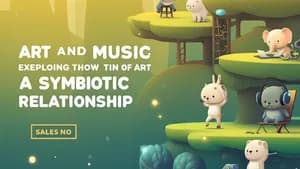From Canvas to Composition: Art as Inspiration in Music
Have you ever listened to a piece of music and felt transported to another world? Maybe you've pictured swirling colors or imagined a grand landscape while the notes danced around you. The power of music to evoke such vivid imagery is a testament to its profound connection with art. Throughout history, artists and musicians have drawn inspiration from each other's works, proving that creativity thrives on cross-pollination.
This article delves into the fascinating relationship between art and music, demonstrating how composers and musicians find inspiration in visual art. We'll explore how the visual world can spark musical ideas, from the evocative landscapes of Turner inspiring Debussy's compositions to the abstract forms of Kandinsky influencing Schoenberg's atonal music. This journey will highlight how visual art serves as a catalyst for musical innovation, offering you a deeper understanding of how art can enrich your musical journey.
The Language of Color and Sound
Imagine yourself standing before a vibrant painting, the brushstrokes leading your eyes through a dynamic composition. You might notice the interplay of light and shadow, the harmonious arrangement of colors, and the sense of depth and movement. These elements, translated into musical terms, become the building blocks of a composition.
Music, like art, uses a vocabulary of its own, with elements like melody, harmony, rhythm, and timbre working together to create a cohesive whole. Just as a painter uses color to evoke emotions, a composer utilizes these musical elements to paint sonic landscapes, expressing feelings, ideas, and narratives.
For instance, the interplay of light and shadow in a painting can be translated into the interplay of contrasting melodies in a musical piece. The dynamic range of colors can be reflected in the dynamic range of musical sounds, from pianissimo whispers to fortissimo bursts of energy. By understanding this connection between visual and auditory elements, you can begin to appreciate the artistic depth of both mediums.
From Impressionism to Impressionistic Music
Think of the Impressionist painters like Monet and Renoir. Their works captured fleeting moments in time, focusing on light and color to evoke a sense of atmosphere and emotion. Similarly, Impressionistic music, characterized by its delicate melodies, shimmering harmonies, and flowing rhythms, attempts to capture the ephemeral beauty of fleeting moments.
Claude Debussy, a pioneer of Impressionistic music, was deeply influenced by the work of J.M.W. Turner, a Romantic painter known for his dramatic landscapes. Turner's paintings, often depicting natural phenomena like storms or sunsets, inspired Debussy's evocative use of color and imagery in his compositions. For example, Debussy's piano piece 'Clair de Lune' (Moonlight) captures the ethereal beauty of moonlight on water, drawing upon Turner's mastery of light and shadow to create a mesmerizing sonic atmosphere.
You can use these examples to explore the relationship between art and music. Listen to Debussy's 'Clair de Lune' while looking at Turner's paintings. Notice how the musical phrases seem to mimic the brushstrokes, the harmonies evoke the color palette, and the rhythms reflect the movement of light and shadow.
Abstract Art: A Catalyst for Atonality
Moving beyond the realm of representational art, we enter the world of abstract art, where form and color take on a new significance. Artists like Wassily Kandinsky and Paul Klee explored the expressive power of pure form, color, and line, departing from traditional notions of realism.
Similarly, in music, composers like Arnold Schoenberg and Anton Webern, pioneers of atonal music, moved away from traditional tonality, exploring new ways to create musical structures. Kandinsky's abstract paintings, with their vibrant colors and dynamic compositions, provided a visual framework for Schoenberg's groundbreaking atonal compositions. The absence of a tonal center in Schoenberg's music mirrors the absence of traditional subject matter in Kandinsky's paintings, creating a sense of freedom and exploration.
To understand this connection, look at a Kandinsky painting and listen to a Schoenberg piece simultaneously. Observe how the dynamic interplay of colors in Kandinsky's works translates into the dynamic interplay of dissonant chords and unpredictable melodies in Schoenberg's music. You'll begin to see how abstract art can inspire a new way of thinking about music, pushing the boundaries of traditional structures and exploring new possibilities of sound.
Finding Inspiration in Your Own Artistic Journey
The connections between art and music are vast and multifaceted. These examples offer a glimpse into how visual art has inspired some of the most groundbreaking musical works. Now, as you delve deeper into your own musical journey, remember that inspiration can be found everywhere around you.
Use these examples as a springboard for your own exploration. Visit museums, art galleries, and online galleries. Explore the work of different artists and movements. Pay attention to the colors, shapes, textures, and the emotions they evoke. Then, translate these visual elements into musical terms. Experiment with different musical techniques, rhythms, harmonies, and melodies. Let your imagination guide you, and don't be afraid to experiment.
Conclusion
As you continue your musical journey, remember that the world of art is a rich tapestry of inspiration waiting to be explored. From the evocative landscapes of Turner to the abstract forms of Kandinsky, visual art offers a powerful tool for understanding and appreciating the depth of music. By embracing this connection, you can deepen your understanding of music, unlock new creative possibilities, and discover the infinite potential of your own artistic expression.

